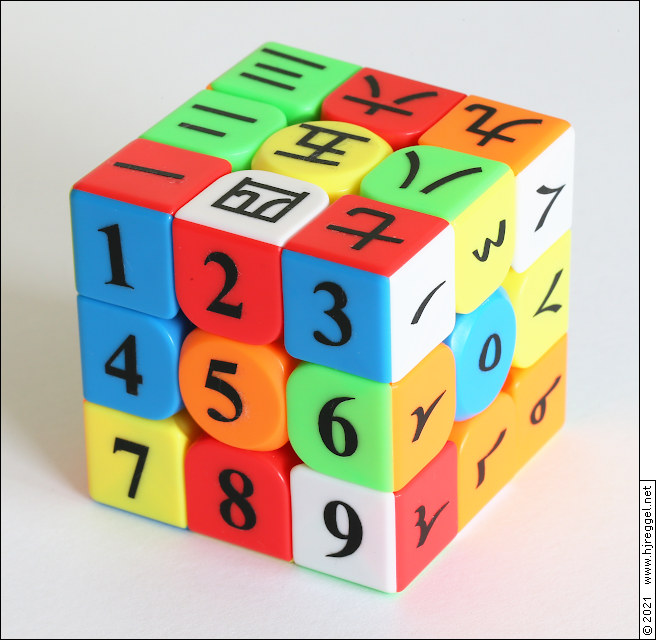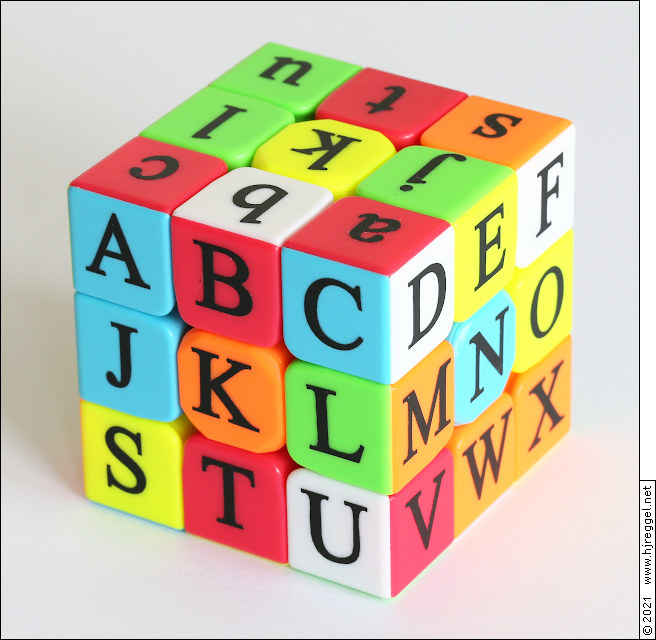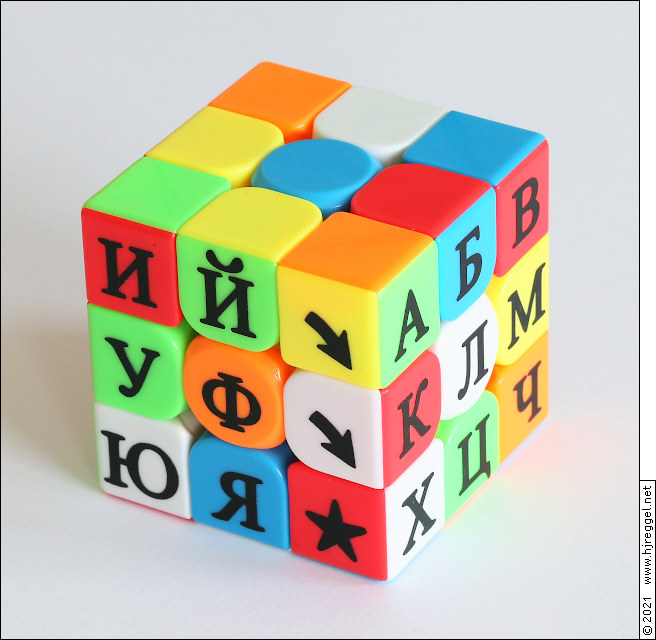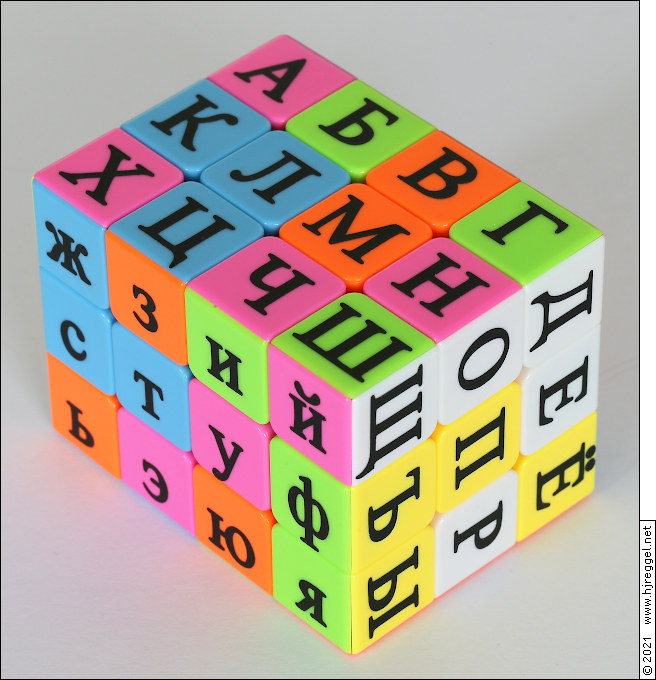 | |
| Numbers Cube - Six different numeral systems: Roman numerals, Ancient Greek and Mayan on the other faces | |
funCUBING Index Page · funCUBING Projects
There are different ways how to indicate placement and orientation of the individual cubies. One method is using well-known sequences, as used for two faces of the Rubik's Domino .
But you can use other sequences, as long as the cuber (or maybe only an insider) can guess what the order of the sequence would be, and how the sequence should be arranged on the cubies.
You can use the same sequence multiple times, but as soon as you use six colors, you get a regular cube with additional information that maybe indicates center orientation. But you could, for example, use numbers 1-9 from different fonts. Please note that the Rubik's Domino used Domino dots on two faces, and two cubie/dot colors to differentiate the two halves.
Usually, such Sequence Cubes are over-determined, because the sequence on one face can be solved witout peeking at the sides. At the same time, such a solved face presets all outer cubie faces of the same layer. Applying the sequence cube principal to higher order cubes will result in Super Cubes, which are hard to solve.
On a 3×3×3 Cube, a sequence of nine on one face will preset three cubie faces on each of the four adjacent cube faces. This gives four stiching hints, either which sequence goes where, or how and where a longer sequence should be continued. Solving one sequence solves 21 out of 54 cubie faces, with only 12 "free" cubies left. Actually, the remaining four corners are already in the correct layer, only the remaining eight edge pieces have to be sorted out. If you solve the sequences on opposite sides, only four middle layer edge pieces have to be placed and oriented. If you use "easy" sequences on opposite layers, the other four can be kept difficult.
As an additional challenge, the sequences can be applied to a scrambled stickerless cube. This will give a "Dual Solution Cube", that can be solved by the underlying stickerless cubie colors, or the sequence information.
If you have sequences that can be identified by shape only, all you need is (matte) black vinyl and a cutting plotter. Important notes: Isolated small dots tend to move and come off easily. Try to maximize the dot size in such cases. Avoid thin lines that segment a shape into several shapes. Try to use bold fonts or the outer offset function of your design software. As a last resort, you can edit critical shapes manually.
 | |
| Numbers Cube - Six different numeral systems: Roman numerals, Ancient Greek and Mayan on the other faces | |
There are many simple concepts using numbers. Some use one number on each face, sometimes with dice patterns. Other examples try to imitate Sudoku squares, where the numbers 1-9 should appear on each face.
There is one very interesting implementation of a "Number Cube" around. The layout was invented by @cuberonce, and the cube was named "Nine Cube". This cube uses numbers from 1 to 9 from different current and ancient numeral systems. The example uses common Indo-Arabic numbers, Roman numerals, Asian number ideographs, Eastern-Arabic numerals, ancient Greek (Milesian) numbers, and Mayan number symbols.
The first commercial Number Cube I ordered had a design flaw: The designer mixed up three pairs of background color, so the cube could not be solved by color. That was the start of my "career" as Sticker Designer.
The original "Nine Cube" had all of the sequences arranged 1-9 left-to-right, top-to-bottom. I decided to arrange the Eastern-Arabic numbers right-to-left, top-to-bottom, and the Asian Ideographs top-to-bottom, right-to-left. The biggest challenge was to find a Mayan font, and learning how to deal with Unicode positions above 0xFFFF. If you don't want to achieve highly sophisticated Unicode typesetting skills, you might be better off designing the rectangles and circles yourself.
 | |
| Latin Alphabet Cube - Symbols & and @ used as fillers on 27th position | |
If you start thinking about longer sequences, you can use letters from alphabets, for example.
The current standard Latin/Roman alphabet has 26 letters. With only one additional symbol, you can cover three faces. Using uppercase and lowercase will perfectly fill a 3×3×3 Cube. As lowercase filler, I chose the "At" symbol @, because it resembles a lowercase letter. As uppercase filler, I used the "And" / "Ampersand" symbol &, because it looks funny, its weight is similar to that of the uppercase letters, and the name is similar to at.
You can use nine lines of three letters across three vertically adjacent faces, or three lines of 9 letter across three horizontally adjacent faces. The lines of three variant is easier to solve than the lines of nine variant.
For a sticker project, isolated small dots are a problem. In case of the Latin Alphabet Cube, lowercase i and j are the problem childs. The cube shown here is still the first version of one of my first cutting projects. Nowadays, I would try to increase the dot size to its visually acceptable maximum.
 | |
| Greek Alphabet Cube - Stigma, Koppa and Sampi used as fillers after the modern alphabet | |
The modern Greek Alphabet only has 24 letters, so there are three symbols missing to fill 27 cubie faces. But there's no need to come up with fancy fill characters!
Ancient Greek used the "Milesian System", where letters were used for numbers as well.
In modern Greek, there are three "lost" symbols, that were originally used as numbers.
The original symbols are:
"Digamma" for number 6,
which was later replaced by the symbol "Stigma" (sigma-tau ligature),
"Koppa" for number 90, and
"Sampi" for number 900.
So I simply used Stigma, Koppa and Sampi as fillers after the modern Alphabet. I could have placed them at their original positions, but that would have been too confusing. Maybe one day I create a "Milesian Cube", where I put the symbols 1-9, 10-90 and 100-900 on respective faces - and maybe hebrew alphabetical numerals on the other three faces.
Here, the nine lines of three were chosen. For a non-Greek person, it's hard enough to know the sequence. Skipping would be a bit difficult.
Once again, the cube is highly over-determined, but like this you could manage to solve it, even if you don't know all Greek letters, yet. But you will learn! How many do you already know from Math, Physics and Chemistry?
 | |
| Cyrillic Alphabet Cube - Three lines of eleven plus filler | |
When I created the Latin and Greek Alphabet Cubes, I was already thinking about a Cyrillic Alphabet Cube. But the Cyrillic Alphabet has too many letters. There are some that could be left out, but by cutting the alphabet down to 27, it would not be an alphabet anymore. One benefit of the Alphabet Cubes should be to have an entertaining way to learn foreign scripts.
When I wrote this article, I realized that there are many different ways to create Sequence Cubes. One option is to use four faces around, having 36 tiles. That is enough to fit the Cyrillic Alphabet. The question is, how many characters there are. I do count "Е" and "Ё", as well as "И" and "Й" as individual characters, so my Cyrillic alphabet has 33 characters. These can be perfectly split into three lines, together with a "stiching indicator" at the end of the first two lines, and a fancy "end of alphabet" marker at the end of the third line.
With four faces around, the cube is already fully determined, except for the orientation of the upper and lower centers. Using the suggested layout, "О" and "Ф" end up on centers, so having the cap height slightly off-center will help orienting these properly. A tiny downward offset helps to create enough space for the ye-dots and i-kratkoe breve.
A drawback of using the full alphabet is that only upper case or lower case letters can be used. But most of the printed cyrillic upper and lower case letters are very similar, so this is not a serious drawback. But you could create two versions, or come up with a way to use a twisty puzzle with more than 56 cubie faces.
 | |
| Cyrillic Alphabet Cuboid - Three lines of eleven characters, Upper and Lower Case Letters Uppercase continued on the bottom face, Lowercase start on the two other faces | |
While writing down the notes about the Cyrillic Alphabet Cube, I realized that a 3×3×4 cuboid has the exact structure for three lines of eleven characters. These run across three adjacent faces 4×3, 3×3 and 4×3 (4+3+4). One could use eleven lines of three characters, but that would fragment the alphabetical sequence too much.
The resulting Cuboid is very hard to solve by Alphabeht, when using regular Cuboid solving strategies. The most common strategy solves the inner corners first, with the need to determine the correct letter for the given spot. When solving the outer edge pieces, the inner corner get mixed up temporarily, destroying a big part of the alphabetical sequence.
In this case, a better strategy would be to solve the top layer and the second layer sequentially, and then pairing up the lower two layer corners and edges. Then the lower two layers could be solved as a pair, just as a 3×3×2, without messing up individual layers.
funCUBING Index Page · funCUBING Projects · Top of Page